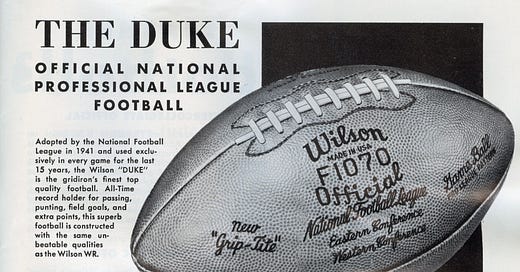The Ball Since 1934
Despite the rule changes of 1929 and 1934, some teams continued using footballs that strayed from the specifications. Others, like Dutch Meyer at TCU, worked with manufacturers to ensure they received footballs meeting the NCAA's maximum length and minimum circumference, resulting in the skinniest possible ball that remained within the NCAA’s tolerances. Other potential abuses led the 1939 rule makers to require referees to check the balls submitted by the home team before each game to confirm they met the NCAA's pressure, weight, and shape specifications. The home team was to provide a pressure gauge, scale, and metal template with a hole cut in a shape that allowed a regulation ball to pass snugly through the hole.

The shape and size of the football have changed minimally since 1934, though the NCAA made minor changes in 1982. At that point, the long axis circumference was allowed to be 1/4 inch shorter, the midsection circumference fell from 21 ¼ to 21 ½ to 20 ¾ to 21 ¼, or a reduction of ½ to ¼ inches, and the length could be slightly shorter or longer than before.
NFL and AFL Balls
Professional football became dominant after the NCAA reduced the ball's size in 1934, so professional football has had virtually no impact on the ball's size and shape other than maintaining the status quo. As we will see in later chapters, the NFL's influence has been on the ball’s quality and durability, starting with improving the quality of the leather in the 1950s and the manufacturing quality control measures implemented by Wilson over the decades. Nevertheless, the slight differences in the balls used in the colleges and professional leagues and their effect on passing have been a consistent theme over the years.
Keep reading with a 7-day free trial
Subscribe to Football Archaeology to keep reading this post and get 7 days of free access to the full post archives.




